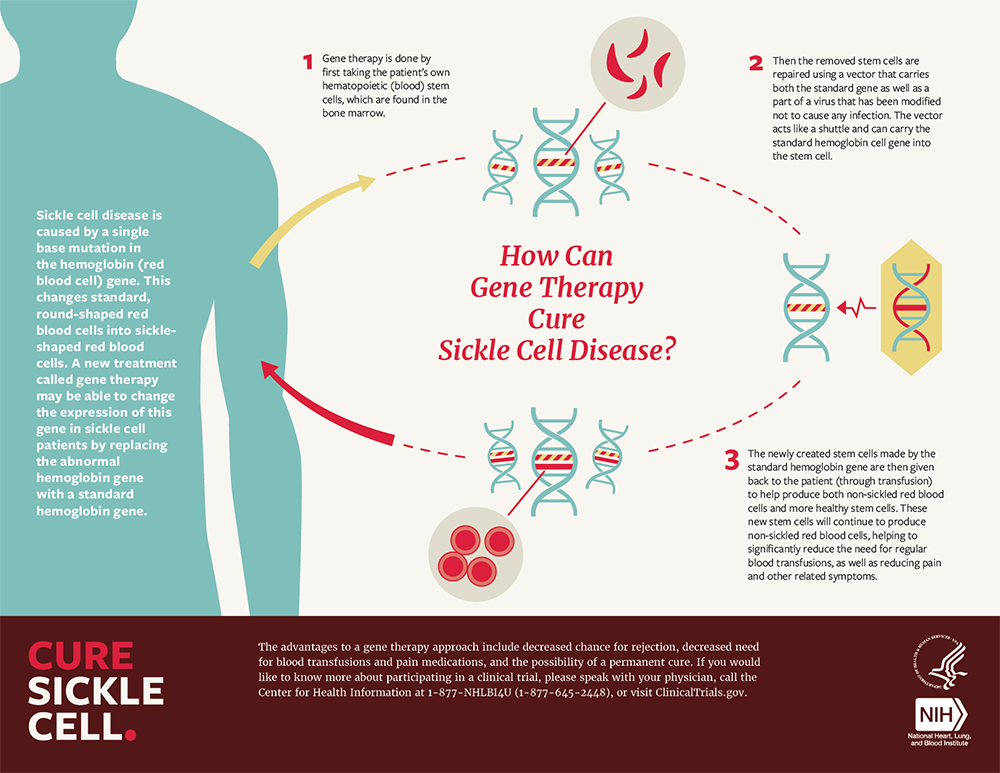Gene Therapies for
Sickle Cell Disease

About Gene Therapies
Gene therapies are techniques for treating diseases that involve changing or adding a gene.
One approach being studied in sickle cell disease involves adding new genetic information to the hematopoietic stem cells (immature cells that can develop into any type of blood cell). This new information instructs red blood cells to silence the expression of a gene that prevents fetal hemoglobin from being made in adult red cells. This reverses a process that occurs naturally after birth and boosts the fetal hemoglobin while at the same time reduces the sickle hemoglobin in red blood cells. The increase in fetal hemoglobin and reduction in sickle hemoglobin can eliminate the symptoms or complications of SCD.
Another approach uses gene editing to change the sickle mutation back to healthy hemoglobin. This gene editing is also done in a patient’s hematopoietic stem cells. After being transplanted into the patient, it is hoped that these gene edited cells will produce enough red blood cells that make healthy hemoglobin and cure sickle cell disease.
Gene therapies that modify a person’s own hematopoietic stem cells may provide a cure for people who do not have a well-matched donor.
Importantly, while these approaches have the promise to improve quality of life (QOL) the individual will still have cells in the body that contain the sickle gene (the reproductive cells – sperm/egg) and can pass on the gene to future generations.
In late 2023, the U.S. Food and Drug Administration (FDA) approved Casgevy and Lyfgenia, the first cell-based gene therapies for the treatment of sickle cell disease. Patients who have received either of these therapies, which use different ways to change the expression of an individual’s genes to make more fetal hemoglobin, will continue to be monitored for many years to make sure that the treatments are safe and effective and to assess long-term outcomes.
Genome Editing
Genome editing (also called gene editing) is a group of technologies that gives scientists the ability to change the DNA in a cell. These technologies allow genetic material to be added, removed, or altered at particular locations in the genome.
Genome editing is of great interest in the prevention and treatment of human diseases and is being explored in a wide variety of diseases, including cystic fibrosis, hemophilia, and sickle cell disease.
CRISPR-Cas9: An example of genome editing
Several approaches to genome editing have been developed: a recent one is known as CRISPR-Cas9, which is short for Clustered Regularly Interspaced Short Palindromic Repeats and CRISPR-associated protein 9. The CRISPR-Cas9 system is faster, cheaper, more accurate, and more efficient than other existing genome editing methods.
How it Works
CRISPR-Cas9 was adapted from a naturally occurring genome editing system in bacteria. The bacteria capture snippets of DNA from invading viruses and use them to create DNA segments known as CRISPR arrays. The CRISPR arrays allow the bacteria to "remember" the viruses (or closely related ones). If the viruses attack again, the bacteria produce RNA segments from the CRISPR arrays to target the viruses' DNA. The bacteria then use Cas9 (or a similar enzyme) to cut the DNA apart, which disables the virus.
Effects of Gene Editing
Changing the DNA in a person is not currently possible, but it is possible to change the DNA in several types of cells, like in some of the stem cells of the bone marrow. The stem cells give rise to mature blood cells, and this can be enough to prevent sickle cell disease. Importantly, this does not change the DNA in the other cells of the body. Therefore, the person who has this type of gene editing treatment can still pass the disease on to their children.
SOURCE:
National Library of Medicine


How viruses help find genetic cures
Some gene therapies are performed by collecting bone marrow cells from a patient, correcting the incorrect DNA in the collected cells, and then returning the modified cells to the body.
Researchers have found ways to use non-infectious parts of certain viruses to make the gene therapies that correct the incorrect DNA. Viruses are used because of their ability to easily transfer DNA into cells.
This technique has been used in research for many years to treat various diseases, including Severe Combined Immunodeficiency syndrome (SCID), thalassemia, Wiskott-Aldrich syndrome, as well as various cancers.
Viruses and Sickle Cell Disease
One approach being studied for sickle cell disease is using modified viruses to carry or deliver the healthy hemoglobin gene into the body. This is done by removing the parts of the virus that cause disease and by replacing it with the corrected genetic material (healthy hemoglobin), which is then returned to the patient.
A group of viruses, called lentiviruses, is used and when used in gene therapy, they are called lentiviral vectors. HIV, one example of Lentiviral vectors, do not contain the infectious part of the virus and cannot give a person HIV/AIDS.
FOR MORE INFORMATION ON GENE THERAPIES, VISIT:
nhlbi.nih.gov/health-topics/genetic-therapies
genome.gov/genetics-glossary/Gene-Therapy


